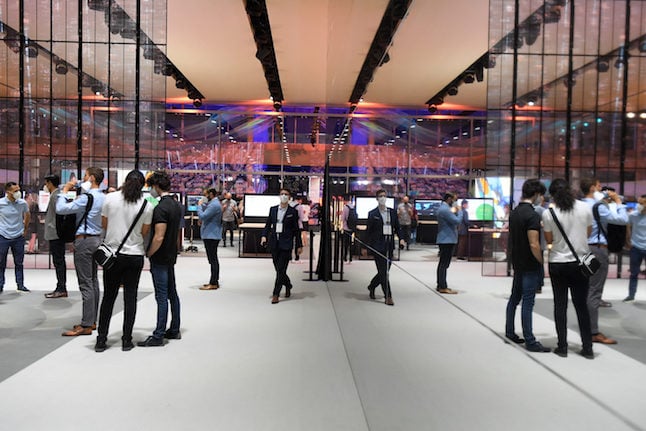For many, it’s been a long time since they’ve been able to enjoy such face-to-face contact since the start of the pandemic, with the event held on the sidelines of Mobile World Congress.
The congress is the telecom industry’s largest annual gathering and one of the first big conferences to be staged in Europe since the health crisis took hold. It took place between June 28th and July 1st 2021.
“We may all work in digital, but face-to-face contact is essential. This kind of event is so much richer here than through a screen,” said Mikael Schachne, a marketing director with Belgian telecom firm Bics, as he breathes in the sea breeze.
“It’s the beginning of a recovery. Given the context, it’s very exciting.”
Cancelled last year as the pandemic gathered pace, MWC went ahead this year at Barcelona’s main conference centre, both in-person and online.
The event is usually an opportunity for firms to unveil new products and for their executives – who pay hefty entrance fees – to network and make deals.
But this year many major firms such as Samsung stayed away citing virus concerns – although some took part virtually – and there were far fewer social events like the gathering on the yacht.
And visitor numbers were also significantly lower, with organisers setting a 50,000 cap compared with more than 100,000 who visited the 2019 show.
Virus measures
And that meant participating companies got less exposure. Waiting by his company’s deserted stand, Huan Xiao, who runs the French subsidiary of TVCMall, a Chinese wholesaler of smartphone accessories, had a
long face.
“Our main objective here is to find new customers to promote our brand. If there is not so many results, I don’t know if we’ll come next year,” he said.
The congress took place under strict health and safety requirements, with participants required to undergo Covid-19 testing every two days, wear medical-grade FFP2 masks at all times and maintain social distancing.
At times, the rules made interaction difficult. When groups gathered around a stand, congress staff would remind them that they needed to stay at least 1.5 metres (five feet) apart.
Mats Granryd, director-general of the GSMA industry association that runs the congress, said everyone knew this year’s edition would be “different”. “But from an industry perspective, we need to be showing that we can continue to do business, and business is best done by seeing each other,” he told AFP.
To encourage contacts, participants could enter their interests into an app which would pair them with others with similar interests. They could then meet in person or by video chat.
‘Worth it’
But Rebeca Perez, head of Spanish real estate start-up Invertis, said the app “worked really badly”, telling AFP she missed the scannable badges with personal information worn by participants that were dropped this year to discourage physical contact.
“They made connecting much easier. You could see right away if the person interested you,” Perez said. But in the end the congress, she said, was almost “more useful than in other years. Because the people who are here are those I wanted to meet”.
Organisers said firms had sent much smaller teams to the event but those that came tended to occupy senior positions.
“It feels kind of empty… but I believe it was worth it,” said Barinderpal Singh Mumick, vice president for business development at Dotgo, a small US messaging firm.
At this year’s show, he had about 40 meetings, half the usual number, he said. “It’s the first time I travel in 18 months and it feels good. It helps to get business back. You can sign deals virtually and physically, but physically it’s a little faster,” he said.
READ ALSO:



 Please whitelist us to continue reading.
Please whitelist us to continue reading.
Member comments